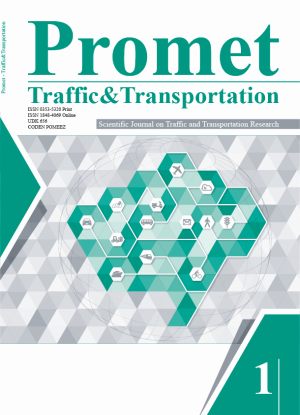Various Approaches to Reduce Consequences of Pedestrian−Tram Front End Collision
DOI:
https://doi.org/10.7307/ptt.v35i2.81Keywords:
passive safety, trams, head injury, pedestrian collision, tram safety, evaluationAbstract
Safety of rail vehicles is an important feature of sustainable public transport. Proofs of an effort in that area are new recommendations and regulations from the expert commission (WG2 of the Technical Committee CEN / TC 256) regarding trams and light rail vehicles aimed at vulnerable road users. Additional requirements on tram safety can be requested by the vehicle operator and/or city. Pedestrian safety measures can be adopted from the automotive sector utilising the protection principles from Regulation EC No. 78/2009, ECE/UN regulations, and EuroNCAP tests. The purpose of this publication is to introduce a simplified testing method for the tram front end with respect to pedestrian head-on collisions. Testing methods based on segment impactors were generally accepted. The wrap-around distance defines the assessment of vehicle impact areas. A mathematical model was created to compare the results of the full-scale tests and the segment tests done by the standard and simplified aluminium head impactors. The tram front-end design can be tested using this alternate method, based on a simple impactor and easy methodology, providing an efficient tool to inspire both the tram manufacturers and vehicle operators to improve the vulnerable road users’ safety in city traffic.
References
Stanton NA. Advances in human aspects of transportation, Proceedings of the AHFE 2021 Virtual Conference on Human Aspects of Transportation, 25-29 July 2021, USA. 2021. DOI: 10.1007/978-3-030-80012-3.
Chen P-L, Jou R-C, Saleh W, Pai C-W. Accidents involving pedestrians with their backs to traffic or facing traffic: An evaluation of crash characteristics and injuries. Journal of Advanced Transportation. 2016;50(5). DOI: 10.1002/atr.1372.
Arregui-Dalmases C, et al. Pedestrian protection overview. Encyclopedia of automotive engineering. 2014.
Naznin F, Curie G, Sarvi M. Safety impacts of platform tram stops on pedestrians in mixed traffic operation: A comparison group before–after crash study. Accident Analysis & Prevention. 2016;86:1-8. DOI: 10.1016/j.aap.2015.10.007.
Nasri M, Aghabayk K, Esmaili A, Shiwakoti N. Using ordered and unordered logistic regressions to investigate risk factors associated with pedestrian crash injury severity in Victoria, Australia. Journal of Safety Research. 2022;81:78-90. DOI: 10.1016/j.jsr.2022.01.008.
Shivakumar K, Deb A, Chou C. An exploration of jute-polyester composite for vehicle head impact safety countermeasures. SAE International Journal of Materials and Manufacturing USA. 2018;11(4). DOI: 10.4271/2018-01-0844.
Teschke K, et al. Bicycling crashes on streetcar (tram) or train tracks: Mixed methods to identify prevention measures. BMC Public Health. 2016;16:617. DOI: 10.1186/s12889-016-3242-3.
D’Apuzzo M, et al. Towards a better understanding of vulnerability in pedestrian-vehicle collision. International Conference on Computational Science and Its Applications – ICCSA 2021. Springer Nature Switzerland AG; 2021. p. 557-572. DOI: 10.1007/978-3-030-87016-4_40.
TR 17420. Railway applications - Vehicle end design for trams and light rail vehicles with respect to pedestrian safety. Technical Committee CEN/TC 256; 2020.
JASTI CO. LTD. Anthropomorphic test devices Dummy. https://www.jasti.co.jp/en/product/dummy. html#pedestrian [Accessed 9th June 2021].
Brdička M, Samek L, Sopko B. Continuum mechanics [Mechanika kontinua]. Prague: Academia; 2005.
Ansys. LS-Dyna – Multiphysics Solver. http://lstc.com/products/ls-dyna [Accessed 9th June 2021].
https://www.lstc.com/download/dummy_models
EUR-Lex. Regulation (EC) No 78/2009 of the European parliament and of the council of 14 January 2009 on the type-approval of motor vehicles with regard to the protection of pedestrians and other vulnerable road users, amending Directive 2007/46/EC and repealing Directives 2003/102/EC and 2005/66/EC. https://eur-lex.europa.eu/legal-content/EN/ALL/?uri=CELEX:32009R0078.
Crash analysis criteria description, Version 2.1.1. Workgroup Data Processing Vehicle Safety. 2008. https://vdocument.in/crash-analysis-criteria-arbeitskreis-messdatenverarbeitung-fahrzeugsicherheitcrash.html?page=1.
United Nations Economic Commission for Europe (United Nations Economic and Social Council). Regulation No 94 of the Economic Commission for Europe of the United Nations (UN/ECE) — Uniform provisions concerning the approval of vehicles with regard to the protection of the occupants in the event of a frontal collision. OJ L 254 20.09.2012. p. 77. http://data.europa.eu/eli/reg/2012/94/oj.
Wismans J, et al. Injury biomechanics. Eindhoven University of Technology; 1994.
Namjoshi DR, et al. Towards clinical management of traumatic brain injury: A review of models and mechanisms from a biomechanical perspective. Dis Model Mech. 2013 Nov;6(6):1325-38. DOI: 10.1242/dmm.011320.
Hozman J, Bradáč J, Kovanda J. Neural tissue response to impact – Numerical study of wave propagation at level of neural cells. Neural Network World. 2014;24(2):157-176. DOI: 10.14311/NNW.2014.24.010.
Downloads
Published
How to Cite
Issue
Section
License
Copyright (c) 2023 Roman Ježdík, Vladislav Kemka, Jan Kovanda, František Lopot, Hynek Purš, Barbora Hájková

This work is licensed under a Creative Commons Attribution-NonCommercial 4.0 International License.







